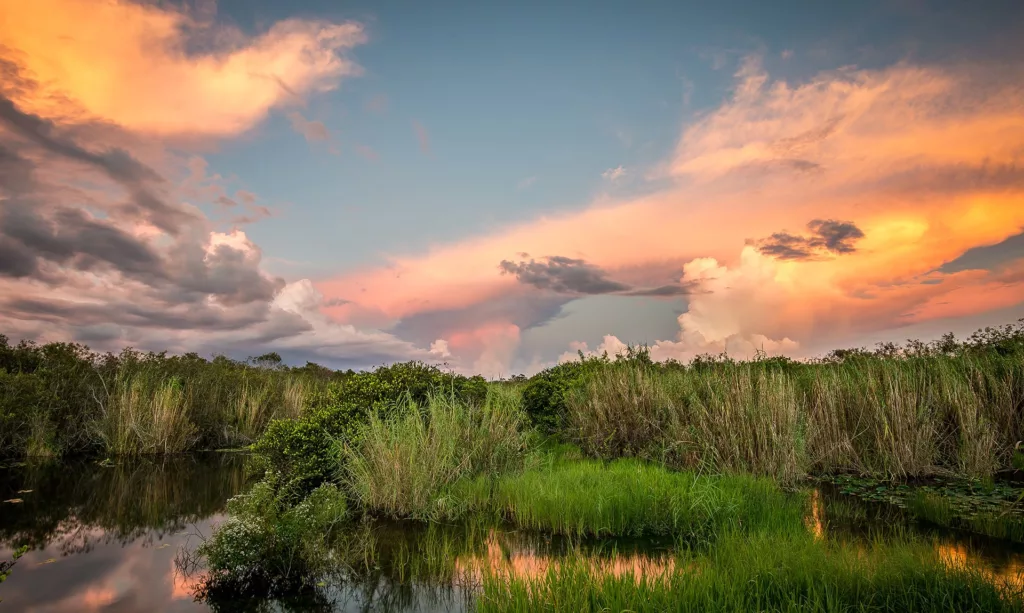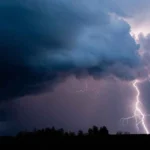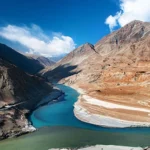
Everglades National Park, located in southern Florida, is a unique and ecologically diverse landscape known for its expansive wetlands, rich wildlife, and historical significance. As one of the largest national parks in the United States, it offers visitors a variety of recreational opportunities and a chance to experience the beauty and complexity of its natural environment. From birdwatching and hiking to cycling and photography, the park attracts millions each year who seek to explore its unique features and contribute to ongoing conservation efforts. Here are some interesting and verified facts about Everglades National Park that highlight its cultural, ecological, and recreational importance.
Established: Everglades National Park was officially established on December 6, 1947, making it the first national park in the United States created primarily to protect a unique ecosystem. The establishment of the park was a significant step towards conservation efforts in the U.S., highlighting the importance of preserving natural habitats. It was designated as a national park to protect the subtropical wilderness that is home to diverse wildlife and plant species, as well as to preserve the cultural heritage of the Native American tribes that have lived in the region for thousands of years.
Size: Covering approximately 1.5 million acres, or about 2,400 square miles, Everglades National Park is one of the largest national parks in the United States. This vast expanse of land is crucial for maintaining the biodiversity of the region. The park’s size allows for a variety of ecosystems to thrive, including freshwater marshes, mangroves, and hardwood swamps. The sheer scale of the park provides critical habitats for numerous species, making it a vital component of Florida’s natural landscape.
Location: Situated in southern Florida, primarily in Miami-Dade County, Everglades National Park is bordered by the Atlantic Ocean to the east and the Gulf of Mexico to the west. Its unique geographic position allows it to serve as a natural filter for water flowing from Lake Okeechobee into the coastal waters. The park’s location is characterized by a subtropical climate, which contributes to its rich biodiversity and makes it an essential area for both wildlife and plant species that thrive in warm, wet environments.
Biodiversity: The Everglades is renowned for its biodiversity, housing over 1,000 species of plants, 400 species of birds, and 300 species of fish. This rich variety of life is due to the park’s diverse ecosystems, which include wetlands, pinelands, and hardwood swamps. The unique combination of freshwater and saltwater habitats supports a wide range of species, some of which are found nowhere else in the world. This biodiversity is not only crucial for ecological balance but also provides opportunities for scientific research and education.
Endangered Species: Among the many species that call the Everglades home, several are classified as endangered. The Florida panther, with an estimated population of 120-230 individuals, is one of the most iconic endangered species in the park. Conservation efforts are vital for the survival of this subspecies of cougar, which relies on the park’s habitat for hunting and breeding. Additionally, the American crocodile, another endangered species, thrives in the brackish waters of the Everglades, highlighting the importance of protecting these critical habitats for vulnerable wildlife.
Water Flow: The Everglades is often referred to as a “slow-moving river,” with water flowing southward at a rate of about 0.25 miles per day. This slow flow is essential for maintaining the health of the ecosystem, as it allows for the natural distribution of nutrients and supports the growth of various plant species. The water flow is influenced by seasonal rainfall and the interconnectedness of the park’s wetlands, which play a crucial role in filtering water and providing habitats for countless organisms.
Wetlands: Everglades National Park is the largest subtropical wilderness in the United States, recognized for its vast wetlands that are designated as a World Heritage Site, a Wetland of International Importance, and a Biosphere Reserve. These wetlands serve as critical habitats for wildlife, support biodiversity, and provide essential ecosystem services such as water filtration and flood control. The park’s wetlands are characterized by sawgrass marshes, mangroves, and cypress swamps, all of which contribute to the unique ecological balance of the region.
Climate: The park experiences a tropical rainforest climate, with an average annual rainfall of about 60 inches. This rainfall is crucial for sustaining the diverse ecosystems within the park. The climate contributes to the lush vegetation and supports the wide variety of wildlife that inhabit the area. The wet season typically runs from May to October, bringing heavy rains that replenish the wetlands, while the dry season from November to April allows for cooler temperatures and lower humidity, attracting many visitors to the park.
Visitor Numbers: In 2020, Everglades National Park recorded approximately 1.1 million visitors, making it one of the most popular national parks in the United States. These visitors come to experience the unique landscapes, diverse wildlife, and recreational opportunities the park offers. The park’s accessibility and range of activities, including hiking, birdwatching, and kayaking, contribute to its popularity. Visitor numbers can fluctuate seasonally, with peak visitation typically occurring during the cooler winter months when many tourists seek to escape colder climates. During these peak periods, the park’s trails, waterways, and wildlife viewing areas can become quite busy, while the summer months tend to see fewer visitors due to the heat and the increased likelihood of rain.
Historical Significance: The establishment of Everglades National Park was not only a pivotal moment for conservation in the United States but also a recognition of the cultural and historical significance of the area. The park was created to protect the unique subtropical ecosystem and the habitats of indigenous peoples, particularly the Seminole Tribe, who have lived in the region for thousands of years. Archaeological evidence suggests that Native American habitation in the Everglades dates back over 5,000 years, and their traditional knowledge of the land has been integral to the area’s history. The park serves as a testament to the importance of preserving both natural and cultural heritage, and it continues to be a site for research and education about the history and ecology of the region. The ongoing collaboration between the National Park Service and the Seminole Tribe highlights the significance of cultural preservation alongside environmental conservation.
Largest Ecosystem: Everglades National Park contains the largest subtropical wilderness in North America, encompassing a diverse array of habitats that support a rich variety of wildlife. This vast ecosystem is characterized by its interconnected wetlands, including sawgrass marshes, mangrove forests, and cypress swamps. The park’s size and ecological diversity make it a crucial area for biodiversity conservation, as it provides essential habitats for numerous species, some of which are endemic to the region. The preservation of this ecosystem is vital for maintaining the ecological balance and supporting the myriad of life forms that depend on it.
Flora: The park features an impressive variety of plant life, including over 40 species of orchids, such as the rare ghost orchid (Dendrophylax lindenii). This particular orchid is known for its striking appearance and elusive nature, making it a sought-after sight for botanists and nature enthusiasts. The diverse plant communities in the Everglades play a crucial role in supporting the park’s wildlife, providing food and habitat for many species. The rich flora also contributes to the overall health of the ecosystem, as plants help filter water, stabilize soils, and provide oxygen.
Fire Management: Fire is a natural and essential component of the Everglades ecosystem. The park uses controlled burns as a management tool to mimic natural fire cycles, which help maintain the health of various habitats. These prescribed burns reduce the buildup of dead vegetation, promote the growth of fire-adapted plant species, and create openings in the canopy that allow sunlight to reach the forest floor. By managing fire in this way, park officials can help maintain the ecological balance, support wildlife habitats, and reduce the risk of uncontrolled wildfires that could threaten both the park and surrounding communities.
Water Management: The Everglades is part of the Greater Everglades Ecosystem, which includes Lake Okeechobee and surrounding areas. Water management is a critical aspect of maintaining the health of the park’s wetlands, as the natural flow of water has been altered by human activities, including agriculture and urban development. Efforts are ongoing to restore the natural hydrology of the area, which is essential for preserving the unique habitats and biodiversity of the Everglades. These restoration projects aim to improve water quality, enhance wildlife habitats, and ensure that the park continues to function as a vital ecosystem.
Temperature Range: The climate of Everglades National Park features an average temperature range from about 60°F (15°C) in winter to 90°F (32°C) in summer. This warm, humid climate supports a diverse array of plant and animal species that thrive in subtropical conditions. The temperature fluctuations throughout the year influence the behavior and migration patterns of various wildlife, including birds and reptiles. The seasonal changes also affect the park’s ecosystems, with the wet season bringing heavy rainfall that replenishes the wetlands and the dry season allowing for cooler temperatures, which can attract more visitors to the park.
Unique Habitats: The Everglades is renowned for its diverse habitats, which include sawgrass marshes, hardwood swamps, and mangrove forests. Each of these habitats plays a vital role in supporting the park’s rich biodiversity. Sawgrass marshes, for instance, are essential breeding grounds for many bird species and provide habitat for fish and other aquatic life. Mangrove forests serve as critical nurseries for juvenile fish and protect coastal areas from erosion. The variety of habitats within the park allows for a wide range of ecological interactions and contributes to the overall health of the ecosystem.
Invasive Species: Invasive species pose a significant threat to the native wildlife and ecosystems of Everglades National Park. One of the most notable invasive species is the Burmese python, which has established a substantial population in the park. These large constrictor snakes prey on native wildlife, disrupting the food chain and threatening the survival of various species. Efforts are underway to control invasive species through monitoring, removal programs, and public awareness campaigns to protect the park’s native ecosystems and preserve its biodiversity.
Research: Everglades National Park is a critical site for ongoing ecological research, focusing on various aspects of the park’s unique environment. Scientists study water quality, wildlife populations, and habitat restoration efforts to better understand the complexities of the ecosystem. Research conducted in the park contributes to the development of effective management strategies and informs conservation practices. The park also collaborates with universities and research institutions to enhance scientific knowledge and promote public awareness about the importance of preserving this unique ecosystem.
Cultural Heritage: Everglades National Park contains archaeological sites that date back over 5,000 years, revealing the rich history of Native American habitation in the region. These sites include artifacts, shell mounds, and ancient dwellings that offer insights into the lives and cultures of the indigenous peoples who once lived in the Everglades. The park preserves these historical remnants, providing valuable information about the early inhabitants’ adaptation to the unique environment of the Everglades. These cultural artifacts are a testament to the deep connection between the Native American communities and the landscape they inhabited.
Fishing Regulations: Recreational fishing is permitted in Everglades National Park, but strict regulations are enforced to protect the park’s delicate ecosystem. These regulations include limits on fishing gear, restrictions on the types and sizes of fish that can be caught, and designated fishing areas to minimize environmental impact. The rules are designed to ensure sustainable fishing practices and to preserve the natural balance of the aquatic habitats. By adhering to these regulations, anglers contribute to the conservation of the park’s diverse fish populations and overall ecosystem health.
Birdwatching: The Everglades is renowned as a premier destination for birdwatching, with over 350 species of birds recorded within its boundaries. This diversity includes wading birds like the great egret and roseate spoonbill, as well as raptors, songbirds, and migratory species. The park’s varied habitats, such as wetlands, hardwood swamps, and pinelands, provide essential stopover points for migratory birds and suitable environments for nesting and feeding. Birdwatchers visit the Everglades to observe these species in their natural habitats, making the park a vital location for avian enthusiasts and researchers.
Accessibility: Everglades National Park offers over 40 miles of hiking trails, providing visitors with numerous opportunities to explore its diverse landscapes. These trails range from easy walks to more challenging hikes, catering to different levels of experience and fitness. In addition to the trails, the park features several visitor centers, such as the Ernest Coe Visitor Center and the Shark Valley Visitor Center, which provide educational exhibits, maps, and information about the park’s natural and cultural resources. These facilities enhance visitor accessibility and offer insights into the park’s unique ecology and history.
Cycling: The Shark Valley area of Everglades National Park features a 15-mile loop road that is popular among cyclists. This paved road offers a scenic route through the heart of the Everglades, allowing cyclists to view a wide array of wildlife, including alligators, deer, and various bird species. The flat terrain and relatively low traffic make it an accessible and enjoyable route for cyclists of all skill levels. The loop road also has designated observation points where cyclists can stop to take in panoramic views of the Everglades’ expansive wetlands.
Photography: Everglades National Park is celebrated for its stunning landscapes and diverse wildlife, making it a favored destination for photographers. The park’s unique scenery includes vast sawgrass prairies, mangrove forests, and intricate water pathways, providing a rich array of photographic subjects. Wildlife such as alligators, wading birds, and the elusive Florida panther offer captivating subjects for wildlife photographers. The interplay of light and natural elements, along with the changing seasons, contributes to the park’s appeal as a prime location for capturing memorable images of nature.
Conservation Efforts: Ongoing conservation efforts in Everglades National Park focus on restoring the natural flow of water through the ecosystem, which has been disrupted by human activities such as urban development and agricultural drainage. These efforts include projects to improve water management, remove invasive species, and enhance the park’s natural hydrology. By addressing these issues, conservationists aim to preserve the park’s unique habitats and support the diverse flora and fauna that depend on a balanced water flow. These restoration initiatives are critical to maintaining the health and resilience of the Everglades’ ecosystem for future generations.
Frequently Asked Questions About Everglades National Park
What is Everglades National Park?
Everglades National Park is the third-largest national park in the United States, located in South Florida. It is known for its unique ecosystem, characterized by sawgrass prairies, mangrove forests, and tropical hardwood hammocks. The park is home to a diverse array of wildlife, including alligators, crocodiles, manatees, and various species of birds.
What is the best time to visit Everglades National Park?
The best time to visit Everglades National Park is during the dry season, which runs from November to April. This is when the weather is cooler and drier, and the park is less crowded. However, the park is still beautiful and accessible during the wet season, which runs from May to October.
What are the main attractions in Everglades National Park?
- The Anhinga Trail: A popular boardwalk trail that offers stunning views of the park’s wildlife and vegetation.
- The Royal Palm Visitor Center: The park’s main visitor center, which features exhibits on the park’s history, ecology, and wildlife.
- The Shark Valley Visitor Center: A tram tour that takes visitors through the sawgrass prairies and offers opportunities to see alligators, birds, and other wildlife.
- The Everglades National Park Wilderness: A designated wilderness area that offers opportunities for hiking, camping, and canoeing.
- The Florida Bay: A shallow bay that is home to a diverse array of marine life, including manatees, dolphins, and sea turtles.
What kind of wildlife can I see in Everglades National Park?
Everglades National Park is home to a diverse array of wildlife, including:
- Alligators and crocodiles: These reptiles are abundant in the park and can often be seen sunbathing on the banks of rivers and canals.
- Manatees: These gentle sea creatures can be found in the shallow waters of the park, especially during the winter months.
- Birds: The park is a birder’s paradise, with over 350 species of birds having been recorded. Some of the most common birds to see include the great egret, the white ibis, and the roseate spoonbill.
- Deer: White-tailed deer are common in the park’s hardwood hammocks.
- Raccoons and opossums: These nocturnal animals can often be seen foraging for food at night.
What are the best activities to do in Everglades National Park?
- Hiking: The park offers a variety of hiking trails that range from easy to challenging.
- Camping: There are several campgrounds located within the park, offering opportunities for overnight camping and stargazing.
- Canoeing and kayaking: The park’s waterways are perfect for canoeing and kayaking, offering opportunities to explore the backcountry and see wildlife up close.
- Airboat tours: Airboat tours offer a thrilling way to experience the Everglades and see alligators and other wildlife.
- Fishing: The park’s waters are home to a variety of fish, including largemouth bass, snook, and tarpon.
What is the best way to get to Everglades National Park?
The best way to get to Everglades National Park is by car. The park is located about an hour south of Miami. There are also public transportation options available, including buses and shuttles.









